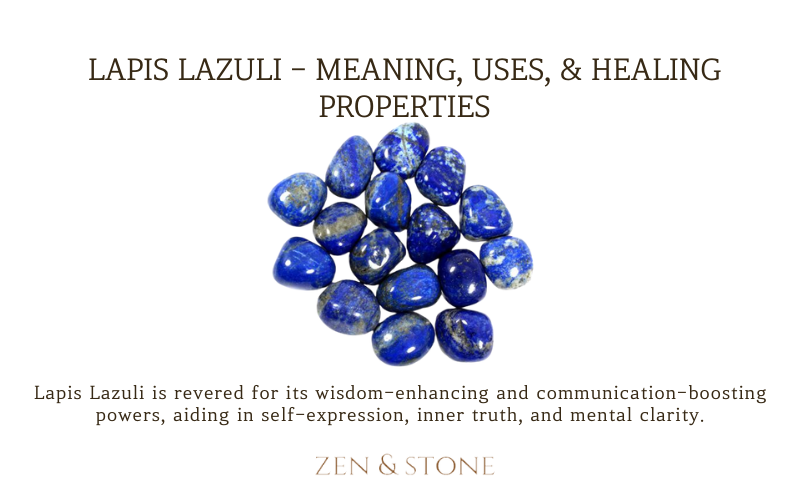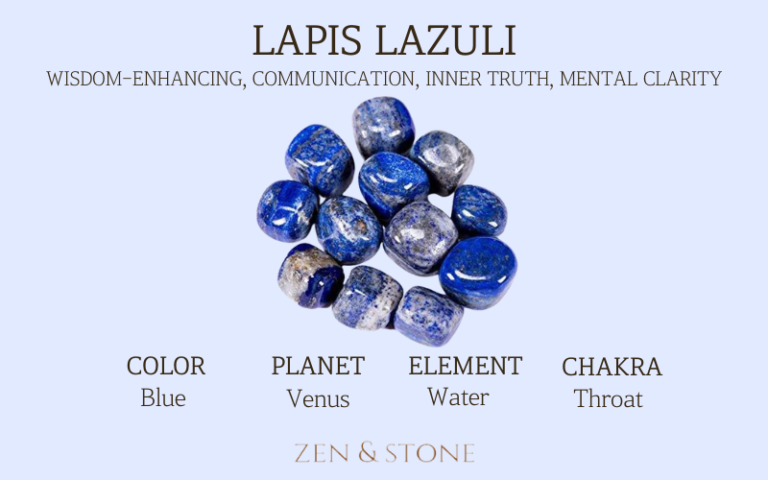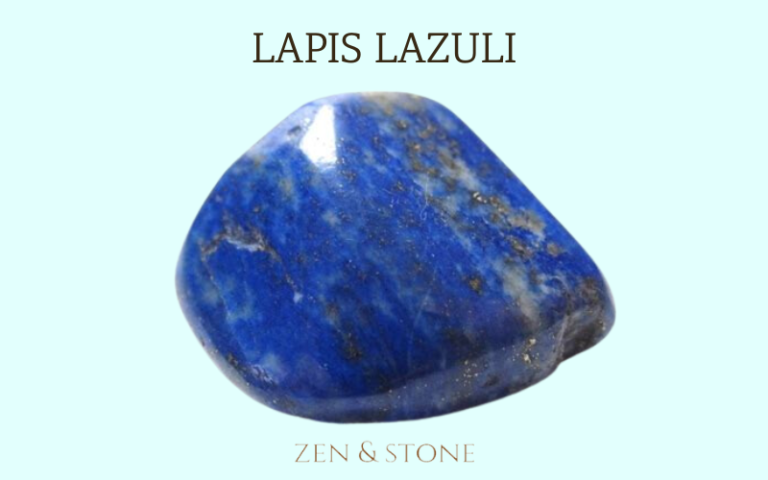
31 Oct Lapis Lazuli – Meaning, Uses, & Healing Properties
Lapis Lazuli is a beautiful blue gemstone that has been prized for its intense color and spiritual properties since ancient times. This metamorphic rock is composed mainly of lazurite, but it may also contain other minerals such as calcite and pyrite. It is a semi-translucent to opaque stone that polishes to a high luster, making it a popular choice for jewelry and decorative objects.
The history and origin of Lapis Lazuli can be traced back to ancient civilizations such as the Sumerians, Egyptians, and Greeks. It was highly valued for its deep blue color, which was associated with the heavens and the divine. Lapis Lazuli was also believed to have healing properties and was used in traditional medicine to treat various ailments. Today, Lapis Lazuli is still highly prized for its beauty and spiritual properties, and it continues to be used in jewelry, art, and spiritual practices.
Origin of Lapis Lazuli
Lapis Lazuli has been prized for its intense blue color for thousands of years. The name “lapis lazuli” comes from the Latin word “lapis,” meaning stone, and the Persian word “lazhuward,” meaning blue. The stone was first mined in the Badakhshan province of Afghanistan as early as 7000 BC.
In ancient times, lapis lazuli was highly valued and traded across the ancient world, from Mesopotamia to Egypt and beyond. The ancient Egyptians used lapis lazuli to create blue cosmetics and jewelry, while the Mesopotamians used it for cylinder seals and amulets.
During the Renaissance, lapis lazuli was ground into a powder to create ultramarine, a deep blue pigment used in paintings. It was so expensive that only the wealthiest artists and patrons could afford to use it.
Today, lapis lazuli is still mined in Afghanistan, as well as in Chile and Russia. It is used in jewelry, carvings, and decorative objects. Its rich blue color and unique veining make it a popular choice for both traditional and modern designs.
Lapis lazuli is also believed to have healing properties, promoting inner peace, wisdom, and communication. It is associated with the throat chakra and is said to help with self-expression and speaking one’s truth.
Physical Properties
Lapis Lazuli is a metamorphic rock that is composed mainly of lazurite, which gives it its characteristic blue color. It is also known to contain calcite, pyrite, and minor amounts of other minerals. Below are the physical properties of Lapis Lazuli:
Color
Lapis Lazuli is known for its striking blue color with flecks of gold pyrite and white calcite. The color can range from deep blue to light blue, depending on the amount of lazurite present in the rock.
Hardness
Lapis Lazuli has a Mohs hardness of 5 to 5.5, which makes it relatively soft compared to other gemstones. This means that it can be easily scratched or damaged if not handled with care.
Luster
Lapis Lazuli has a vitreous to dull luster, which means that it can range from shiny to matte depending on the quality of the stone. The pyrite inclusions can also give the stone a metallic luster in some cases.
Transparency
Lapis Lazuli is usually opaque, which means that light cannot pass through it. However, some higher quality stones can be semi-translucent, allowing some light to pass through the stone.

Uses of Lapis Lazuli
Lapis Lazuli has been used for various purposes throughout history. Here are some of the most common uses of Lapis Lazuli:
Jewelry
Lapis Lazuli has been used to create jewelry for thousands of years. It was highly valued by ancient civilizations such as the Egyptians, who used it in their burial masks and other funerary objects. Today, Lapis Lazuli is still used to create beautiful and unique pieces of jewelry. It is often cut into cabochons, beads, and pendants, and set in silver or gold.
Pigments
Lapis Lazuli has been used as a pigment for centuries. It was ground into a fine powder and used to create a vivid blue pigment called ultramarine. This pigment was highly prized by Renaissance artists such as Michelangelo and Raphael, who used it to create their masterpieces. Today, Lapis Lazuli is still used to create high-quality pigments for artists and designers.
Decorative Items
Lapis Lazuli has been used to create a wide range of decorative items throughout history. It was often carved into figurines, vases, and other objects of art. In addition, it was used to create decorative tiles and mosaics. Today, Lapis Lazuli is still used to create a variety of decorative items, including bowls, boxes, and bookends.
Symbolism and Cultural Significance
Lapis Lazuli has been prized for its symbolism and cultural significance throughout history. The stone’s bright blue hue evokes feelings of wisdom and truthfulness, traits that have been associated with royalty and power.
In ancient Egypt, Lapis Lazuli was believed to have mystical properties and was often used in religious ceremonies. The Egyptian Pharaoh Osorkon II even wore a pendant made from solid gold and Lapis Lazuli, symbolizing his high status and connection to the divine.
In other cultures, Lapis Lazuli was believed to provide protection from evil spirits and promote inner peace and harmony. It was often used in amulets and talismans to ward off negative energy and bring good luck.
Today, Lapis Lazuli continues to be valued for its symbolism and cultural significance. It is often used in jewelry and decorative objects, and its rich history and associations with power and royalty make it a popular choice for collectors and enthusiasts.
In addition to its aesthetic appeal, Lapis Lazuli carries spiritual significance in various cultures. It is associated with qualities such as wisdom, truth, and inner peace, and is believed to promote spiritual growth and enlightenment. Overall, Lapis Lazuli remains a highly valued and sought-after stone, prized for its beauty, symbolism, and cultural significance.
How to Use Lapis Lazuli for Healing
In a world filled with gemstones and crystals believed to possess mystical properties, lapis lazuli stands out as a captivating gem known not only for its deep blue beauty but also for its unique healing uses. For centuries, this gem has been revered for its potential to heal, empower, and enlighten those who seek its energies. In this blog, we will dive into the world of lapis lazuli and explore its fascinating healing attributes.
A Stone of Enlightenment:
Lapis lazuli, with its vibrant blue hue reminiscent of the endless sky and the deep oceans, has been referred to as the “Stone of Enlightenment.” Ancient civilizations like the Egyptians, Sumerians, and Greeks believed that lapis lazuli could awaken one’s inner wisdom and expand their consciousness. It is thought to stimulate the Third Eye Chakra, enhancing intuition, insight, and self-awareness.
Mental Clarity and Emotional Healing:
Lapis lazuli is said to have a calming and soothing effect on the mind. It can help alleviate stress, anxiety, and depression, allowing for mental clarity and emotional healing. The stone’s energy is believed to balance the Throat Chakra, aiding in effective communication and self-expression.
A Shield Against Negative Energies:
In many spiritual traditions, lapis lazuli is considered a protective stone that wards off negative energies. It is believed to create a shield around the wearer, preventing psychic attacks and harmful influences. Some even use it to dispel nightmares and promote peaceful sleep.
Physical Healing Properties:
Beyond its metaphysical attributes, lapis lazuli is associated with physical healing as well. It is believed to assist with ailments related to the throat, respiratory system, and the thyroid gland. Additionally, it can help alleviate migraines and headaches, acting as a natural pain reliever.
Creative Expression and Inspiration:
Many artists and writers turn to lapis lazuli for inspiration and creativity. It is thought to open the doors of imagination and encourage self-expression. Carrying a lapis lazuli stone or wearing it as jewelry can boost artistic endeavors and problem-solving skills.
Meditation and Spiritual Growth:
Lapis lazuli’s serene and spiritual energy makes it an ideal companion for meditation and inner exploration. It is believed to deepen your meditation experiences, connect you to your higher self, and foster spiritual growth.
Chakra Balancing:
Lapis lazuli is often associated with the Throat and Third Eye Chakras. By wearing lapis lazuli jewelry or meditating with it, one can potentially balance and align these energy centers, which may lead to a sense of harmony, self-expression, and spiritual insight.

Conclusion
Lapis Lazuli is a precious gemstone that has been admired and valued for centuries. Its deep blue color and golden speckles make it a unique and beautiful stone, and it has been used for a variety of purposes throughout history. Lapis Lazuli has been used as a decorative stone in jewelry and other ornamental objects, as well as a pigment in paintings and other artworks. It has also been used for its spiritual and healing properties, believed to promote inner peace, clarity, and communication. Overall, the significance of Lapis Lazuli lies in its beauty, versatility, and cultural and spiritual significance.

Sorry, the comment form is closed at this time.